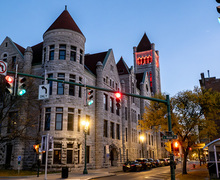Greeking out: Some Greek life traditions hold true, some fade out over time
Wandering through campus, students can frequently be seen proudly decked out in their fraternity or sorority letters. More than just letters in the Greek alphabet, these symbols represent tight-knit communities of brothers or sisters. Although many may equate greek life to nothing more than parties, there’s a long history of traditions behind these social, academic and service organization. Here are a few that run deep in Syracuse University’s greek community.
The ATO Cannon
It all started with a gift from an alumnus in 1922. Rumored to be from the Civil War, the cannon symbolized the wars between the Orange football team and their opponents. Four brothers from Alpha Tau Omega, dubbed cannoneers, wheeled the gun to each home game and blasted it after every Orange touchdown and winning game.
The cannon became the main target for pranks; students from Cornell and Colgate enjoyed trying to steal the cannon. Once, four Colgate men snuck onto the sideline and tried to run the cannon across the stadium toward their own side. ATO brothers, Orange cheerleaders, the Alpha Chi Rho bell crew and various SU fans chased them down, creating a brawl.
In 1926, during a winning game against Vermont, touchdown after touchdown made the cannon hotter and hotter. Suddenly, when the cannon fired, the ramrod tore through the cannoneer’s shirt. The cannon was banned for 11 years. A freak accident in 1960 injured seven students with only minor injuries. Although the students recovered, the cannon’s presence never did.
Valentine’s Day Run
This Delta Tau Delta tradition required a sophomore brother of the fraternity to run across the Quad for three laps and kiss every girl he came across. He did this wearing only a pair of white boxer shorts with a pattern of hearts.
The tradition originated when a brother wanted to go on a date but could not afford to do so. His brothers agreed to pay for the date if he agreed to run around the Quad as Cupid on Valentine’s Day and kiss as many women as he could. It stuck.
For a while, the brother who ran got a bucket of money. Later, the run turned into a week of fundraising, which included a dance and a dating show for the American Heart Association. Each smooch cost 2 to 3 cents in donations. The records reached upwards of 300 lucky ladies.
House Dogs
The saying goes that a dog is a man’s best friend. Throughout the years, many fraternities and sororities kept a variety of pets — rabbits, monkeys, goldfish and ferret. But nothing is more common and traditional than dogs.
Archive pictures show that the tradition of a canine as a house mascot goes as far back as 1891 with Delta Kappa Epsilon’s pooch. A St. Bernard lived in Sigma Alpha Epsilon in 1957, and Zeta Psi cleverly named its canine Psi.
To show that the dogs are truly part of the fraternities, some fraternities include their dogs in composite photos that show the faces of all members in the house. They usually display the house dog in the middle, sometimes dressed in a suit similar to what the brothers wear in the photo. Today, it’s not uncommon to see brothers of houses, such as Phi Kappa Psi, walking down Comstock or Walnut avenues with a dog trailing close by.
Paddles
On the second floor of the Syracuse University Bookstore, wooden paddles of all different shapes and sizes dangle on a wall. Many fraternity and sorority students still buy them and continue the tradition, even if they do not use the paddles for the original purpose of hitting new members or pledges.
Now, ‘Littles,’ younger members of a sorority, decorate them and give them to their ‘Bigs,’ the older members, to show their appreciation for being ‘adopted’ into the house. Though current greek houses use the tradition, past fraternities and sororities that used paddles were Phi Mu in 1955, Sigma Phi Epsilon in 1949 and Sigma Nu in 1941.
Published on November 9, 2011 at 12:00 pm
Contact Colleen: cbidwill@syr.edu





